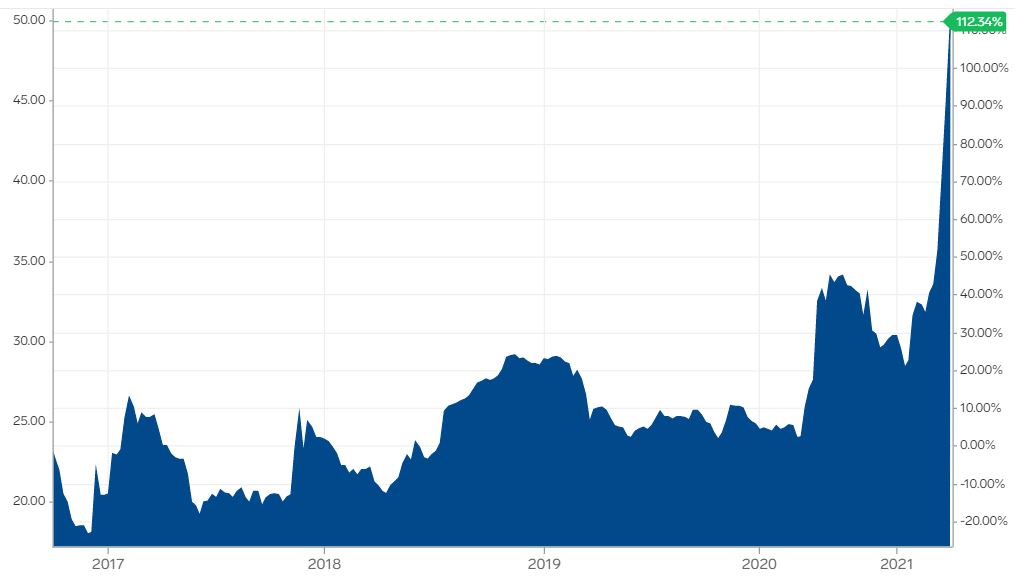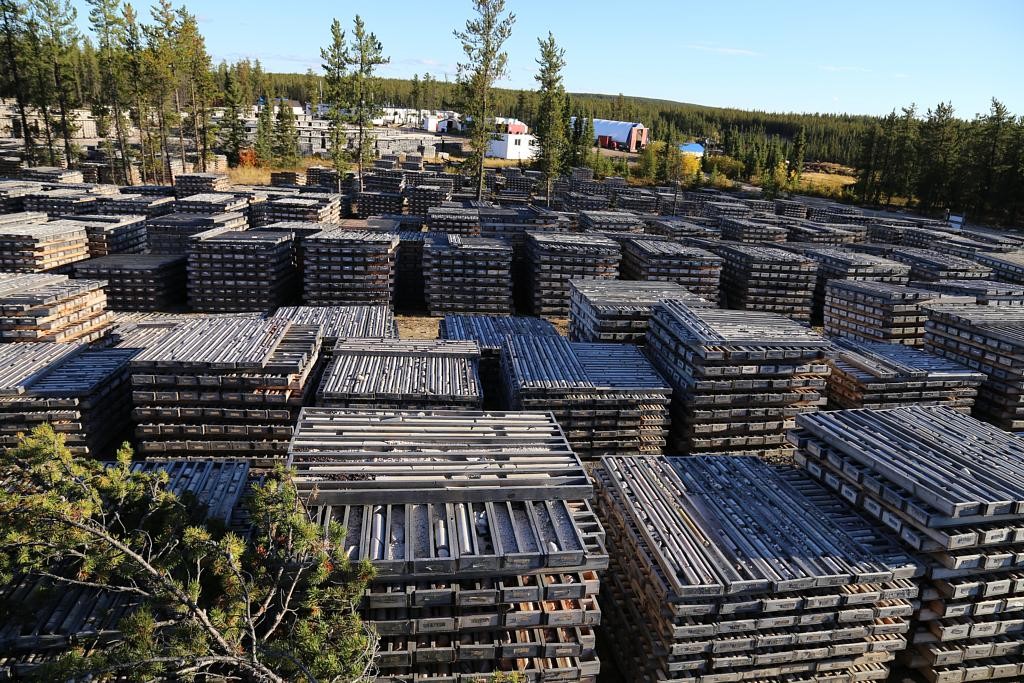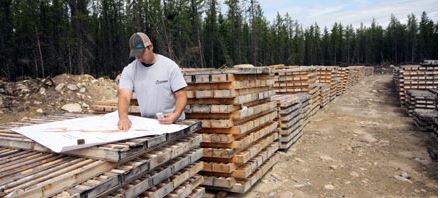Uranium: An overlooked mineral suddenly in play

By Rodney Blake
Major market corrections tend to come unannounced out of nowhere when things seem to be going particularly well. They can be quite devastating and can drop markets by well over 20% in just a matter of a day or two. The Dotcom bust of 2000, 9/11, the Financial Crisis of 2008 and the recent Covid-19 correction of 2020 are good examples of major market corrections. Luckily, most corrections become buying opportunities as they come in the context of a major bull market as stock prices recover in a relatively quick manner and the market resumes its bull run. The current Covid-19 correction and market recovery is a prime example of a correction within a major bull market. It took the S&P 500 just 6-months to recover the 1,200 points it lost in March 2020 and has now accented another 1,100 points to record highs of about 4,500. Sometimes however, corrections can turn into bear markets and take longer to regain prior levels as post correction events keep shell shocked investors on the sidelines. Case in point – Due to the resulting recession it took the S&P 500 Index over 5-years to recover to its pre 2008 Financial Crisis level of 1,600.

Occasionally, markets collapse and stay down for an extended period of time and go almost unnoticed in a major bear market. Which brings us to uranium as the focus of this column. I remember the collapse in uranium markets very well. I had just returned from the annual Prospectors & Developers Association of Canada (PDAC) Conference in Toronto in early March of 2011 where the price of uranium and uranium stocks was one of the highlights of the show. Just to recap – energy was in vogue and the price of uranium had recently risen from about US$60-a-pound to a record high of some US$105. There was much excitement regarding the few uranium producers and many uranium exploration plays in the Athabasca Basin of northern Saskatchewan and elsewhere throughout the world. Myself as a broker and many of my clients were enjoying this amazing bull market. What could go wrong? What could go wrong was when, just one week later and out of nowhere on March 11th – a massive tsunami tidal wave hit the East coast of Japan. The resulting devastation also flooded and knocked out of commission three of that country’s nuclear reactors. The price of uranium immediately plunged to just US$20 as Japan, one of the world’s largest users of uranium, and many other countries shut down their nuclear reactors as that type of power production suddenly was deemed to be too dangerous. Ultimately, the price of uranium stocks also collapsed as professional and retail investors quickly left this toxic sector.
That event was 10-years ago and the price of uranium has remained range bound in a price of US$20 – $25 for most all of that time. Major uranium producers were forced to cut back or close production facilities. Many junior uranium companies were forced to give up their uranium holdings and move on to other mineral endeavours as uranium projects received little if any investor interest and were almost impossible to finance. Except for a few instances – there has been little if any interest in uranium exploration.
Then, starting late last year and more so this year the outlook for uranium started to change. The inventory surpluses created by the industry shutdown 10-years earlier have for the most part have been greatly reduced and returned to more normal levels as reactors around the world gradually came back on line. New reactors are being built as the greening of the planet puts more emphasis on clean nuclear power. Uranium producers, noting that $25 uranium was under their cost of production used surplus cash to buy U3O8 in the spot market. More recently, investment funds have accelerated the drawdown of uranium inventories by entering the market and accumulating large holdings of yellowcake. Because of the small size of the market, uranium is quite easily bought and stored for future use or sale. Much easier to store than a warehouse full of copper or a super tanker of oil. The net result is that the price of uranium has now broken the US$25 ceiling to achieve a new 10-year high of over US$35. Now, US$35 still isn’t historically a very high price and is well below the cost of production of U3O8 for most producers, but the break-out of a 10-year trading channel to a 10-year high catches the market’s attention.
Bull markets tend to start quietly and often go unnoticed by most investors. Most of the buying and the market moves tend to come at the end of the rally rather than the beginning. Case in point – When gold bullion made headlines in 2011 as it surged to a then record high of over US$1,700 – I would suggest that most investors weren’t buying bullion when the bull market actually started in 2000 with the price gold bullion at just US$275. The length and magnitude of a bull market can also be related to the length of the bear market that preceded it. When gold bullion made that historic 11-year, $1,500 rally it came after an agonizing 19-year bear market that saw the precious metal fall from its previous high of US$850 to the aforementioned US$275. In fact – in the early years of the rally, when the initial gains were small, many market pundits thought that gold bullion would never reach US$850 ever again.
Could the same sort of bull market be setting itself up for uranium. Time will tell, but in this early first uptick, uranium has many of the same characteristics as that of gold some 21-years ago. Uranium is coming off an incredible 10-year bear market and has just broken above a very long  support base of about US$25. Uranium production is less than the current needs of the world’s reactors. The overhanging stockpile of uranium has mostly been depleted as funds increase their purchases of U3O8. Demand for clean energy is increasing but 10-years of relative inactivity has left the uranium industry with only limited increases in supply. Should this US$35 level hold then the next upside target could be somewhat higher.
How should investors play this uranium market? The uranium market is different than most mineral markets. Uranium orebodies and production rates are relatively small and are often measured in pounds as opposed to tonnes for most minerals other than precious metals. Uranium, although one of the world’s most widely occurring minerals, is very elusive to find in minable concentrations. Therefore most of the world’s production comes from only three countries, Kazakhstan, Canada and Australia. To add to the complexity of uranium, many otherwise mineral friendly jurisdictions such as British Columbia and Quebec have outlawed uranium production, and Saskatchewan, with the world’s richest uranium reserves, doesn’t want nuclear reactors in the province.
Unlike the gold or copper industries – There are very few primary uranium producers to chose from – especially those that trade on an organized exchange. There are also a limited number of exploration companies that have viable orebodies or discoveries to develop. And although it is possible to purchase physical uranium, it is somewhat awkward to store physical U3O8 on ones premises or in a safe deposit box. More grass roots uranium exploration companies will no doubt emerge if this turns into a real market, but for now they are few and far between. I’m not aware of any new new uranium mines coming forward and those few with established orebodies face years of permitting and environmental hurtles to overcome. With so few clear choices it would seem that a small number of ETFs that cover uranium production, exploration & development, and physical delivery would give most investors an overall exposure to this long overlooked commodity. An informed investor could also leverage their ETF positions with a limited number of well researched individual companies.
Uranium could be setting itself up to be the next resource market darling. So far this year, gold and silver, except for a brief New Year rally have disappointed. Copper peaked mid-year at $4.75 but has since drifted lower. Crude oil rallied to US$70 and is now consolidating those gains . Trouble is – the petroleum industry, while now profitable, is losing investors to the green energy theme. And now long forgotten uranium has suddenly jumped higher by $10. Should the current price hold, there could be nothing but blue sky ahead for some time to come. All of which brings us to the uranium market of today.
The uranium market has made an encouraging short term run but could it be setting itself up for a major long term bull market? A number of indicators would suggest this might be so. Similar to gold bullion, uranium seems to be breaking out from a very long term bear market. The commodity has built a very long support base at about US$25. Often, the length and magnitude of the resulting bull market rally is comparable to the length and magnitude of the previous bear market. The recent $10 uptick in the price of U3O8 has caught the attention of savvy commodity investment funds and retail investors alike. Post tsunami, the uranium market was awash in oversupply. That surplus, for the most, part has been absorbed by the industry and investors. After 10-years of cutbacks – current producers will need time to return dormant mining facilities to production to meet current demand. There are very few uranium orebodies ready for production. Those projects still face years of permitting issues and environmental ‘Not In My Backyard’ or NIMBY headwinds. Grass roots exploration for uranium has been mostly nonexistent since the market turndown. It will take many years to find and develop new uranium resources. The overall uranium market is quite small when compared to most other mainstream commodity markets. Increased physical buying and storing of U3O8 could greatly magnify further price increases. Some would say this is folly, but it has happened before – In 1979-80 the oil rich Hunt Brothers identified a relatively limited physical silver as compared to the much larger gold market. They entered the market and bought approximately 100-million ounces of physical silver which helped to drive the price from about US$5-an-ounce to a record of over US$50 – twice the magnitude of the gold bullion rally that went from about US$175 to US$850.
Major bull markets tend to focus on something new that hasn’t been overly scrutinised or overanalysed. Uranium fits this criteria. A decade is a long time to be off the investment radar. The global drive to lower carbon emissions is accelerating. And while older investors may remember the highs of 10-years ago – there are many young or new investors today who have never been exposed to uranium and are looking for opportunities to invest in the greening of the planet. Uranium also meets this criteria. Reactors are very environmentally friendly way to produce energy as they have zero carbon emissions. Timing and opportunity are important. Uranium is emerging out of a longterm bear market to be a key component  of the greatest investment topic of the day.
 Well established Denison Mines Corp. [DML-TSX], an iconic name in the global uranium sector, is entering a new phase in its fabled history as it moves to develop a new high-grade deposit in the Athabasca region of Saskatchewan.
Well established Denison Mines Corp. [DML-TSX], an iconic name in the global uranium sector, is entering a new phase in its fabled history as it moves to develop a new high-grade deposit in the Athabasca region of Saskatchewan.
Targeted for initial production in the second half of this decade, the Pheonix deposit on Denison’s flagship Wheeler River property will rank as potentially one of the lowest-cost uranium mines in the world.
The project is being developed at a time when the uranium market is showing signs of a sustained recovery and the beginnings of a new contracting cycle.
Optimism in the sector is being driven by a spike in spot price of uranium, which recently jumped to a of US$50.80 a pound, amid signs that the discretionary supply of the nuclear fuel is dwindling. The hope is that this scenario will prompt utilities to secure supplies of uranium by signing long term contracts with major producers such as Cameco Corp. and Kazakh state owned KazAtomProm
Denison sees itself as a developer of the next phase of uranium assets that are likely to enter the market in the second half of the decade when the price of nuclear reactor fuel could be much higher. Other companies that fit into that category are NexGen Energy Ltd. [NXE-TSX, NYSE] Fission Uranium Corp. [FCU-TSX; FCUUF-OTCQX; 2FU-FSE].
What sets Denison apart from its competitors is uranium extraction plan.

A NI 43-101 compliant pre-feasibility completed for Wheeler River in September, 2018, included the selection of the in-situ recovery mining method for the development of the Pheonix deposit, with an estimated average operating cost of US$3.33 per pound of U308. All-in costs are forecast to be US$8.90 a pound.
In-situ recovery involves processing the uranium while it is still in the ground through the injection of catalyzing agents into the ore.
In-situ-recovery is only possible in porous geological formations (like sandstone) which are amenable to such a technique. On average, the capital spend needed to put an ISR uranium project into production is less than 15% of the cost to build a conventional hard-rock uranium mine.
Aside from the production cost, ISR leaves a much smaller environmental footprint because it does not require the construction of a tailings impoundment facility. Denison is aiming to be the first company to deploy the ISR method at a uranium project in Canada.
In an interview with Resource World, Denison CEO David Cates said company executives are so confident in the technology that they recently announced a decision to advance the Wheeler River project to the feasibility stage.
Wheeler River is the largest undeveloped high-grade uranium project in the eastern portion of Saskatchewan’s Athabasca Basin. Denison is developing the project with its 50% owned JCU (Canada) Exploration Co. Ltd. affiliate. Denison is the project operator and holds an effective 95% interest in the site.
Proven and probable reserves at the site stand at 109.4 million pounds of U3O8. That includes 141,000 tonnes at 19.1% U3O8 or 59.7 million pounds in the Pheonix zone, and 1.26 million tonnes at 1.8% U3O8 or 49.7 million pounds in the Gryphon zone.
A pre-feasibility study for the Pheonix deposit forsees average annual production of 6.0 million pounds of U308 for 10 years.
The completion of the feasibility study is a critical step to the progression of the project and is intended to advance de-risking efforts to the point where the company will be able to make a definitive development decision.
Aside from Wheeler River, Denison’s other key asset in Saskatchewan is a 22.5% ownership interest in the McClean Lake joint venture, which includes several uranium deposits and the McClean Lake uranium mill. The mill is contracted to process ore form Cameco’s Cigar Lake mine under a toll milling agreement.
Earlier this year Denison announced that it procured 2.5 million pounds U3O8, at an average cost of US$29.61/lb U3O8, to strengthen its balance sheet as part of a project financing initiative connected to the future advancement of its flagship Wheeler River project. As of June 30, 2021, the Company also reported having $84.9 million in cash and cash equivalents.
In April, 2021, Denison said it had entered into a participation and funding agreement with the English River First Nation (EFRN), in connection with the proposed in-situ recovery uranium mining operation at Wheeler River.
Denison said these agreements reflect Denison’s desire to operate its business in a progressive and sustainable manner that respects ERFN rights and advances reconciliation with Indigenous people. On October 5, 2021, Denison shares were trading at $1.81 in a 52-week range of $2.29 and 40.5 cents, leaving the company with a market cap of $1.46 billion, based on 805.7 million shares outstanding.
